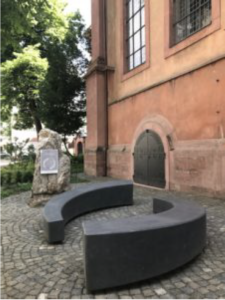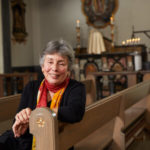Eresa Berger
Blessed are those who mourn, for they will be comforted.
On a recent visit to the city of Mainz, Germany, I came across two intriguing places of mourning, right in the center of the city. The two sites could not have been more different, yet both spoke clearly to the vital importance of “place” in the hard labor of grieving.
What about mourning those who have lost their place?
I was visiting Mainz, first and foremost, to grieve and honor a former bishop of Mainz, Karl Cardinal Lehmann. Lehmann, who had become bishop while I studied theology in Mainz in the early 1980s, had died just a couple of months earlier. His death was widely mourned, not only by the people of his diocese, but also by ecumenical leaders from both East and West with whom he had collaborated, and by leading politicians in Germany for whom he had been a knowledgeable and trusted conversation partner. On the day of his burial, Cardinal Lehmann’s casket was carried in solemn procession through the city center to the cathedral. The Mass of Christian Burial was live-streamed. The final resting place of the bishop—the eighty-seventh successor to St. Boniface as Bishop of Mainz—was in the crypt of the historic cathedral. This place has continued to be one of active, heartfelt mourning. People visit the cathedral just to descend to the crypt, to pray, and to remember. Most recently, the President of Germany paid his respects there. The visitors leave fresh flowers, candles, and scribbled notes of gratitude. Clearly, the mourning for this beloved cardinal is not only deep but also takes place at a truly resonant site: in the historic cathedral, below the high altar at which Karl Cardinal Lehmann presided as Bishop of Mainz for over 33 years. He is buried in his place.
 But what about the labor of mourning when there is no such place? What about mourning those who have lost their place? In walking distance from the cathedral in Mainz is a newly established place of mourning that seeks to respond to those questions. The site was dedicated just a few months ago, as a “Trauerort”—a public place for mourning. It was conceived as an invitation, especially to the many recent migrants and refugees who have been received by Germany over the last few years. Often, these migrants and refugees have not only lost their homes and homelands but also the graves of their beloved dead. Even sadder, some of those who have made their way to Europe have lost loved ones in their very flight from places of violence and conflict. Think only of those lost at sea, on perilous boat journeys across the Mediterranean. How and where to mourn—visibly, noticeably, publicly—when there is no cemetery that houses your beloved dead, and no public memorial to those you left behind?
But what about the labor of mourning when there is no such place? What about mourning those who have lost their place? In walking distance from the cathedral in Mainz is a newly established place of mourning that seeks to respond to those questions. The site was dedicated just a few months ago, as a “Trauerort”—a public place for mourning. It was conceived as an invitation, especially to the many recent migrants and refugees who have been received by Germany over the last few years. Often, these migrants and refugees have not only lost their homes and homelands but also the graves of their beloved dead. Even sadder, some of those who have made their way to Europe have lost loved ones in their very flight from places of violence and conflict. Think only of those lost at sea, on perilous boat journeys across the Mediterranean. How and where to mourn—visibly, noticeably, publicly—when there is no cemetery that houses your beloved dead, and no public memorial to those you left behind?
Surely it is no coincidence that in recent years, online places of mourning, including virtual cemeteries, have risen sharply in number and internet traffic.
 This is where the idea of a Trauerort comes in. Mainz is not the only or first city in Germany that now includes such a place for mourning. The city of Düsseldorf opened a first “intercultural place of mourning” in 2011. In Mainz, the Trauerort is located on the side of a Baroque Catholic church. The parish collaborated in the creation of this public space and offered a part of its own grounds for this Trauerort. It is a quiet spot, in the midst of a busy city. A tree offers shade, and two stone half-circles, which can serve as a bench and/or candle stand, face each other, like two arms that hold something precious in their midst. The design is by the artist Doaa Elasyed, herself a refugee who now lives in Germany. The Trauerort is made complete by a huge, rough, unpolished stone. The text on the stone reads as follows, in loose translation:
This is where the idea of a Trauerort comes in. Mainz is not the only or first city in Germany that now includes such a place for mourning. The city of Düsseldorf opened a first “intercultural place of mourning” in 2011. In Mainz, the Trauerort is located on the side of a Baroque Catholic church. The parish collaborated in the creation of this public space and offered a part of its own grounds for this Trauerort. It is a quiet spot, in the midst of a busy city. A tree offers shade, and two stone half-circles, which can serve as a bench and/or candle stand, face each other, like two arms that hold something precious in their midst. The design is by the artist Doaa Elasyed, herself a refugee who now lives in Germany. The Trauerort is made complete by a huge, rough, unpolished stone. The text on the stone reads as follows, in loose translation:
A Place to Mourn:
For all those who cannot visit the graves of their beloved dead.
For all who have moved here from far away, for refugees and migrants.
For all peoples, of all religions, cultures, and languages.
I am not a refugee, although I sometimes experience myself as a migrant between my country of origin and the other side of the North Atlantic. Yet the sadness of no longer (or very rarely) being able to visit the graves of my beloved dead resonates with me. And given that migration continues to be on the rise globally, I wonder whether places like the Trauerorte in Germany are not important to cultivate in other contexts too. How, for example, do Central and Latin Americans who have moved to North America experience their loss of a public place to mourn their beloved dead?
Surely it is no coincidence that in recent years, online places of mourning, including virtual cemeteries, have risen sharply in number and internet traffic. People need a place to mourn, and to do so visibly, making others witnesses to this mourning. Our churches have long offered such spaces to mourn the dead. Maybe our churches can now enlarge both the spaces for mourning and the circle of mourners, to include today’s global migrants.
 Teresa Berger is professor of liturgical studies and Thomas E. Golden Professor of Catholic Theology at Yale Divinity School and the Yale Institute of Sacred Music. Her most recent monograph, @ Worship: Liturgical Practices in Digital Worlds, was published by Routledge in 2018. She is currently preparing for publication the papers from the 2018 ISM Liturgy Conference on “Liturgy – Cosmos – Creation.”
Teresa Berger is professor of liturgical studies and Thomas E. Golden Professor of Catholic Theology at Yale Divinity School and the Yale Institute of Sacred Music. Her most recent monograph, @ Worship: Liturgical Practices in Digital Worlds, was published by Routledge in 2018. She is currently preparing for publication the papers from the 2018 ISM Liturgy Conference on “Liturgy – Cosmos – Creation.”
